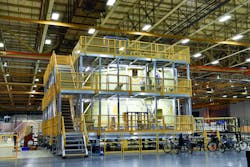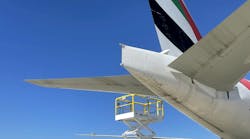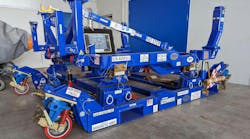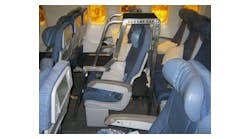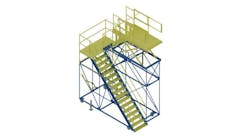In the world of aviation maintenance and manufacturing, there are two key components that personnel, operators and managers strive to achieve: more efficiency and improved safety. Most decisions in terms of purchasing equipment used in both manufacturing and maintenance are influenced by these two concepts.
"Is this going to help my operation run more efficiently?" and "Is this going to better improve the safety of our personnel?" are the questions that need to be answered with positive responses before any piece of equipment is purchased. Two specific pieces of equipment that check these boxes are fixtures and work platforms. Both are designed so that the two components of efficiency and safety are reflected in most of their core features.
Fixtures
Fixtures or jigs are typically used by the aviation maintenance and manufacturing industry to keep work consistent. This allows for the cannibalization of one plane to another in times of need. Situations may arise where there is no time to wait for a new part to come in to ensure that a plane is operable. In these types of situations, this approach will reduce downtime. However, this is only possible if everything is kept incredibly consistent from one plane to another. This consistency is achieved using fixtures.
Through fixtures, one can precisely measure each drill hole and each rivet on an airplane part. By keeping these tolerances precise, it is not inconceivable to interchange wings and panels as necessary. In addition to the flexibility the consistency a fixture provides, there is a safety element as well. Through the use of laser-focused fixtures, there is far less of a possibility of something being manufactured that is not correct to the specification. This means there is a smaller chance of something failing unexpectedly.
In order to develop fixtures that are effective, the tolerances must typically be so tight that laser measurement is recommended to successfully create them.
Work Platforms
Work platforms by their very nature are meant to improve the efficiency of the maintenance personnel that work in the aviation industry. In the simplest terms, work platforms are designed to get maintenance workers closer to the piece of equipment that they are working on. The shapes and sizes of the aircraft being serviced are so unique, there is an entire industry dedicated to the design, customization and manufacturing of work platforms. This customization comes in the form of both size/shape and the different options that can help the platform become more effective in terms of efficiency.
One of the most important aspects of a work platform that improves workflow is the stand’s mobility. Nothing can hinder a platform’s effectiveness more than not being able to place it exactly where it needs to be. In the past, this was a consistent concern. Although work platforms used to be equipped with mounted casters, movement was always extremely difficult. The modern approach, however, is to equip a work platform with multiple wheels on a single caster. This helps to reduce friction, lessening the burden to move it from one place to another. In fact, a single worker can typically move a work platform designed this way that weighs up to 2,000 pounds with ease.
As technology and data-sharing has grown, the work platform has needed to adapt to this digital world. Work platforms are capable of being designed so that there are computer workstations and electrical outlets throughout. There is not a one-size-fits-all approach to this. Ensuring the designer, engineer and end-user are all on the same page with the requirements is key. How many workstations should it be equipped with? What are the electrical requirements (single phase, multi-phase, low voltage)? These are just some of the details that need to be ironed out before the manufacturing stage begins.
Finally, there is the question of adaptability. It makes the most sense from a cost/benefit standpoint for a single work platform to be able to handle working on several different pieces of equipment. This means the platform needs to remain nimble. It needs to have a capability to adapt to several maintenance challenges. The platform must be able to reach different heights and stretch out horizontally in some cases. The goal is to make the work performed by maintenance personnel be as seamless as possible.
In terms of safety, properly designed work platforms play a large role. In order to satisfy OSHA requirements, several scenarios must be accounted for, and the entire platform must meet these strict guidelines. Elements such as load certification must be considered, and surfaces must be designed to reduce slips to avoid injury. There has been a surge in demand for a metallic grit substrate applied to surfaces that need to have superior grip. One of the reasons for its popularity is its durability. The material doesn’t deteriorate much over time.
Fall-restraint tie-off points must be top of mind for the manufacturer as well. Maintenance employees often work at dangerously-high heights. Including enough spots for them to secure themselves is imperative.
Finally, materials used must be considered for safety purposes. Depending on the ultimate application of the work platform, it may be utilized in a volatile environment. In which case, any type of possible spark must be eliminated. This mostly applies to the lighting selection, but also needs to be addressed with the materials used.
Maintenance managers are looking to improve processes both in terms of efficiency and safety. By working closely with designers and manufacturers of both fixtures and work platforms, they can make their way closer to these goals.
About the Author
CMSgt. Charles Clark, USAF (Ret) is the Director of Military Sales Development for WB Industries, a custom metal fabrication company that builds and installs product solutions designed to improve safety, efficiency and performance. Many of WB Industries’ products are integral in local, national and international manufacturing facilities, military bases, aircraft carriers, public areas and within the country’s infrastructure. WB Industries applies customer specific requirements to its projects and work to several industry standards including NASA, Boeing, Lockhead Martin, AMS, AISC, IBC, ASTM and MIL specs.
